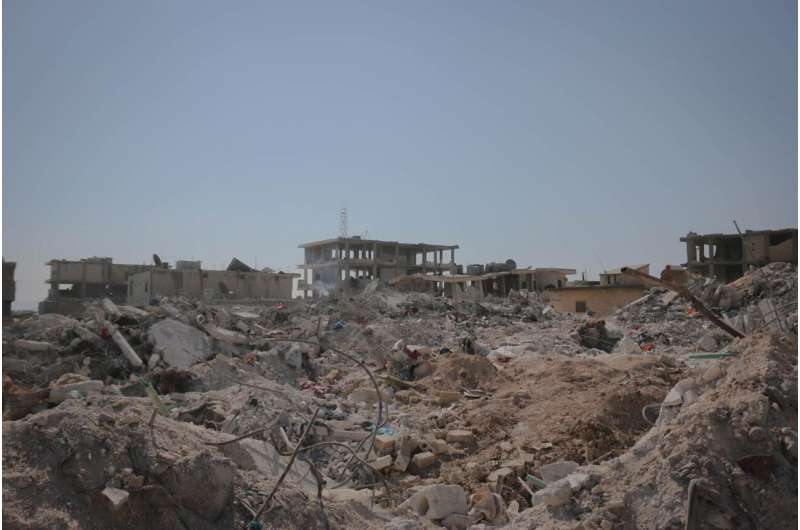This article has been reviewed according to Science X's editorial process and policies. Editors have highlighted the following attributes while ensuring the content's credibility:
fact-checked
trusted source
proofread
Q&A: What Libya's floods, Morocco's earthquake can teach us about resilient infrastructure

On the night of September 8, a magnitude 6.8 earthquake hit Morocco in the Atlas Mountains near the historic town of Marrakesh. The tremor, the biggest to strike the country in over a century, shattered hundreds of buildings and killed nearly 3,000 people.
Two days later, torrential rains caused two dams to collapse near Derna in northeastern Libya. The resulting floods inundated the city, killing more than 11,000 people.
In both tragedies, outdated infrastructure incapable of handling the impact of such disasters resulted in extraordinary death tolls.
Shideh Dashti, an associate professor of civil, environmental and architectural engineering at CU Boulder, studies how infrastructure responds to natural disasters. She shared her thoughts on what engineers can learn from these events and how countries can build resilient cities better prepared for a future likely to see more frequent and intense natural disasters.
What made the earthquake in Morocco so destructive?
The earthquake had a magnitude of 6.8 and was relatively shallow. Being closer to the surface means there was more shaking of the ground, which led to more damage. Also, the earthquake happened at night, when many people were home and asleep.
The vulnerability of buildings and other infrastructure there also played a role. In places like the Moroccan villages, there are a lot of older buildings and unreinforced structures made of stone and brick blocks that tend to collapse during earthquakes. There might also have been newer buildings not built properly following modern codes or standards. These kinds of vulnerabilities can lead to a lot of destruction, which we saw in Morocco, as well as in Turkey earlier this year.
Are earthquakes becoming more frequent or devastating? Does climate change play a role?
Generally, we don't expect the rate or magnitude of natural earthquakes to change due to climate change. However, induced earthquakes can be affected by human activities like fracking or very large dam construction. The aging of infrastructure also influences our vulnerability to earthquakes.
How can buildings be designed to withstand earthquakes?
Unreinforced masonry and older concrete structures are not ductile, meaning they tend to crack and collapse during earthquakes, causing death and injury. Building reinforcement aims to bring ductility to buildings and avoid collapse or excessive damage.
Our building codes don't reduce the risk of collapse to zero, but countries that have good building codes and follow them tend to suffer less damage during hazards like earthquakes. Haiti didn't have building codes in 2010. When the country was hit by earthquakes, the degree of damage was astounding. In countries that have building codes, you wouldn't see as much loss of life from an earthquake of similar size.
What about parts of the world at less risk of earthquakes? What kind of construction standards do they need?
In areas where there is lower earthquake risk, such as parts of the central United States, the infrastructure is designed to resist much weaker ground-shaking. But there are other hazards, like hurricanes, flooding, and wildfires that affect what the building codes should require and how we design our physical infrastructure.
With climate change, we are experiencing extreme weather events more frequently and more intensely than ever before. This increases the likelihood of overlapping or consecutive events in the lifetime of our structures. So in our infrastructure design, we need to take into account the occurrence of such consecutive events.
Research indicates that extreme events like the floods in Libya are likely to become more common due to climate change. Is our infrastructure ready?
Many of these critical infrastructure systems like dams in both developing and developed countries were designed 50 or even 100 years ago. So even if they were designed and constructed perfectly based on the standards that existed at the time, and even if they were maintained perfectly since then, we now have a different hazard level that is projected to increase due to climate change.
Every part of our infrastructure needs to be reassessed based on the new projections of climatic hazards. In the case of Libya, engineers have been warning the country about these dams for a while. But the country has been in political turmoil, and things have been challenging economically. Many developing countries face similar obstacles. These internal events have made it very hard for the government to maintain and strengthen infrastructure.
I think this is a situation where the international community should start to play a role in helping countries protect their populations given the challenges posed by climate change. Some of these countries contribute the least to greenhouse gases while suffering the consequences of climate change disproportionally.
How do we learn from these tragedies?
In the aftermath of each earthquake or flood, we can learn a lot by testing out how buildings and infrastructure performed. For example, in Morocco, structural engineers can find out if any of these building collapses—built following old or new code—were predictable. And we can learn from the quake and subsequent hazards, such as landslides, if we need to update building codes or our design procedures to make the physical infrastructure safer in new construction.
This also applies to Libya. There are already a lot of adequate engineering solutions for making our cities more resilient, but the economic and social sides of the equation make implementing these solutions difficult in many places. These disasters are a reminder for policymakers and funding agencies to invest in research and increase the budget allocated to improving infrastructure safety and adapting to climate change.
Provided by University of Colorado at Boulder




















